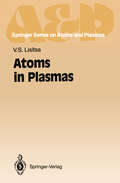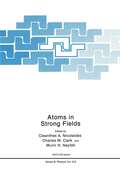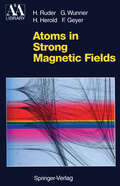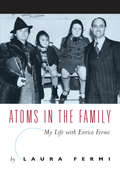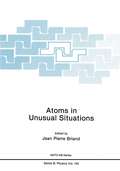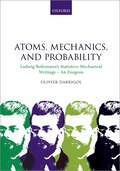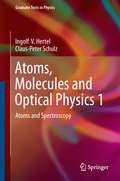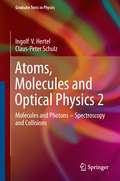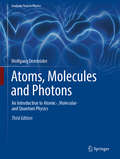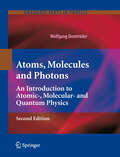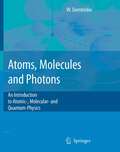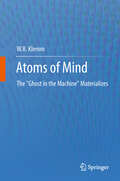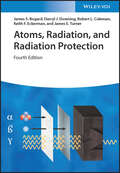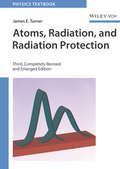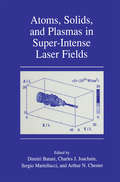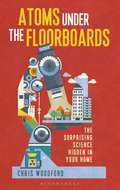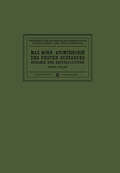- Table View
- List View
Atoms in iron sulphate (UEB uncontracted)
by RnibThis is a diagram showing how the atoms of iron and sulphur are arranged in a crystal of iron sulphate. There is a locator dot shown, which will be at the top left of the page when the image is the correct way up. Small textured circular symbols represent the atoms. There is a key showing the symbols in the bottom left of the page.
Atoms in Plasmas (Springer Series on Atomic, Optical, and Plasma Physics #14)
by Valery S. LisitsaA study of radiative-collisional phenomena in neutral and ionized gases, focusing on a "perturbed atom", i.e an atom under the influence of different perturbations in plasmas, namely by electrical and magnetic fields. The treatment covers fundamental aspects of modern physics, such as atomic quantum mechanics and quantum optics, radiation and collisional processes in plasmas and gases, nonlinear laser spectroscopy, and plasma diagnostics.
Atoms in Strong Fields (Nato Science Series B: #212)
by Efthymios Nicolaidis Charles W. Clark Munir H. NayfehThis book collects the lectures given at the NATO Advanced Study Institute on "Atoms in Strong Fields", which took place on the island of Kos, Greece, during the two weeks of October 9-21,1988. The designation "strong field" applies here to an external electromagnetic field that is sufficiently strong to cause highly nonlinear alterations in atomic or molecular struc ture and dynamics. The specific topics treated in this volume fall into two general cater gories, which are those for which strong field effects can be studied in detail in terrestrial laboratories: the dynamics of excited states in static or quasi-static electric and magnetic fields; and the interaction of atoms and molecules with intense laser radiation. In both areas there exist promising opportunities for research of a fundamental nature. An electric field of even a few volts per centimeter can be very strong on the atom ic scale, if it acts upon a weakly bound state. The study of Rydberg states with high reso lution laser spectroscopic techniques has made it possible to follow the transition from weak-field to strong-field behavior in remarkable detail, using static fields of modest lab oratory strength; in the course of this transition the atomic system evolves from one which can be thoroughly understood in terms of field-free quantum numbers, to one which cannot be meaningfully associated at all with the zero-field states of the atom.
Atoms in Strong Magnetic Fields: Quantum Mechanical Treatment and Applications in Astrophysics and Quantum Chaos (Astronomy and Astrophysics Library)
by Hanns Ruder Günter Wunner Heinz Herold Florian GeyerA clear and accessible introduction to quantum mechanical methods used to calculate properties of atoms exposed to strong magnetic fields in both laboratory and stellar environments, with the emphasis on hydrogen and helium and their isoelectronic sequences. The results of the detailed calculations are listed in tables, making it a useful handbook for astrophysicists and atomic physicists alike.
Atoms in the Family: My Life with Enrico Fermi
by Laura FermiIn this absorbing account of life with the great atomic scientist Enrico Fermi, Laura Fermi tells the story of their emigration to the United States in the 1930s—part of the widespread movement of scientists from Europe to the New World that was so important to the development of the first atomic bomb. Combining intellectual biography and social history, Laura Fermi traces her husband's career from his childhood, when he taught himself physics, through his rise in the Italian university system concurrent with the rise of fascism, to his receipt of the Nobel Prize, which offered a perfect opportunity to flee the country without arousing official suspicion, and his odyssey to the United States.
Atoms in the Family: My Life with Enrico Fermi (History Of Modern Physics And Astronomy Ser. #No. 9)
by Laura FermiIn this absorbing account of life with the great atomic scientist Enrico Fermi, Laura Fermi tells the story of their emigration to the United States in the 1930s—part of the widespread movement of scientists from Europe to the New World that was so important to the development of the first atomic bomb. Combining intellectual biography and social history, Laura Fermi traces her husband's career from his childhood, when he taught himself physics, through his rise in the Italian university system concurrent with the rise of fascism, to his receipt of the Nobel Prize, which offered a perfect opportunity to flee the country without arousing official suspicion, and his odyssey to the United States.
Atoms in the Family: My Life with Enrico Fermi (History Of Modern Physics And Astronomy Ser. #No. 9)
by Laura FermiIn this absorbing account of life with the great atomic scientist Enrico Fermi, Laura Fermi tells the story of their emigration to the United States in the 1930s—part of the widespread movement of scientists from Europe to the New World that was so important to the development of the first atomic bomb. Combining intellectual biography and social history, Laura Fermi traces her husband's career from his childhood, when he taught himself physics, through his rise in the Italian university system concurrent with the rise of fascism, to his receipt of the Nobel Prize, which offered a perfect opportunity to flee the country without arousing official suspicion, and his odyssey to the United States.
Atoms in the Family: My Life with Enrico Fermi
by Laura FermiIn this absorbing account of life with the great atomic scientist Enrico Fermi, Laura Fermi tells the story of their emigration to the United States in the 1930s—part of the widespread movement of scientists from Europe to the New World that was so important to the development of the first atomic bomb. Combining intellectual biography and social history, Laura Fermi traces her husband's career from his childhood, when he taught himself physics, through his rise in the Italian university system concurrent with the rise of fascism, to his receipt of the Nobel Prize, which offered a perfect opportunity to flee the country without arousing official suspicion, and his odyssey to the United States.
Atoms in Unusual Situations (Nato Science Series B: #143)
by Jean P. BriandAtomic Physics is certainly the oldest field in which Quantum Mechanics has been used and has provided the most significant proofs of this new theory. Most of the basic concepts, except those more recently developed in field quantization, have been understood for quite a time. Atomic Physics began to serve as a basis for other fields such as molecu lar, solid state or nuclear physics. A renewal of interest in Atomic Physics began in the sixties, after the discovery of Quantum Electro dynamics, and later when it provided some basic tests of fundamental questions like parity violation, time reversal or Dirac theory. More recently the development of new technologies led to the ex ploration of very extreme cases in which the most secrete aspects of atoms have been observed. - Rydberg states where the atoms are so big that they can be described by classical theories; - Heavy or super-heavy ions or exotic atoms where unknown QED or relativistic effects can be observed (very heavy hydrogenlike or helium like ions, positron production in very violent collisions ••. ); - Huge external perturbations as those appearing in super-dense plasmas or ultra-high fields. The aim of this school was to gather atomic physicists from all over the world working in all these areas of Atomic Physics.
Atoms, Mechanics, and Probability: Ludwig Boltzmann's Statistico-Mechanical Writings - An Exegesis
by Olivier DarrigolOne of the pillars of modern science, statistical mechanics, owes much to one man, the Austrian physicist Ludwig Boltzmann (1844-1906). As a result of his unusual working and writing styles, his enormous contribution remains little read and poorly understood. The purpose of this book is to make the Boltzmann corpus more accessible to physicists, philosophers, and historians, and so give it new life. The means are introductory biographical and historical materials, detailed and lucid summaries of every relevant publication, and a final chapter of critical synthesis. Special attention is given to Boltzmann's theoretical tool-box and to his patient construction of lofty formal systems even before their full conceptual import could be known. This constructive tendency largely accounts for his lengthy style, for the abundance of new constructions, for the relative vagueness of their object—and for the puzzlement of commentators. This book will help the reader cross the stylistic barrier and see how ingeniously Boltzmann combined atoms, mechanics, and probability to invent new bridges between the micro- and macro-worlds.
Atoms, Molecules and Optical Physics 1: Atoms and Spectroscopy (Graduate Texts in Physics)
by Ingolf V. Hertel Claus-Peter SchulzThis is the first volume of textbooks on atomic, molecular and optical physics, aiming at a comprehensive presentation of this highly productive branch of modern physics as an indispensable basis for many areas in physics and chemistry as well as in state of the art bio- and material-sciences. It primarily addresses advanced students (including PhD students), but in a number of selected subject areas the reader is lead up to the frontiers of present research. Thus even the active scientist is addressed. This volume 1 provides the canonical knowledge in atomic physics together with basics of modern spectroscopy. Starting from the fundamentals of quantum physics, the reader is familiarized in well structured chapters step by step with the most important phenomena, models and measuring techniques. The emphasis is always on the experiment and its interpretation, while the necessary theory is introduced from this perspective in a compact and occasionally somewhat heuristic manner, easy to follow even for beginners.
Atoms, Molecules and Optical Physics 2: Molecules and Photons - Spectroscopy and Collisions (Graduate Texts in Physics)
by Ingolf V. Hertel Claus-Peter SchulzThis is the second volume of textbooks on atomic, molecular and optical physics, aiming at a comprehensive presentation of this highly productive branch of modern physics as an indispensable basis for many areas in physics and chemistry as well as in state of the art bio- and material-sciences. It primarily addresses advanced students (including PhD students), but in a number of selected subject areas the reader is lead up to the frontiers of present research. Thus even the active scientist is addressed. This volume 2 introduces lasers and quantum optics, while the main focus is on the structure of molecules and their spectroscopy, as well as on collision physics as the continuum counterpart to bound molecular states. The emphasis is always on the experiment and its interpretation, while the necessary theory is introduced from this perspective in a compact and occasionally somewhat heuristic manner, easy to follow even for beginners.
Atoms, Molecules and Photons: An Introduction to Atomic-, Molecular- and Quantum Physics (Graduate Texts in Physics)
by Wolfgang DemtröderThis introduction to Atomic and Molecular Physics explains how our present model of atoms and molecules has been developed over the last two centuries both by many experimental discoveries and, from the theoretical side, by the introduction of quantum physics to the adequate description of micro-particles. It illustrates the wave model of particles by many examples and shows the limits of classical description. The interaction of electromagnetic radiation with atoms and molecules and its potential for spectroscopy is outlined in more detail and in particular lasers as modern spectroscopic tools are discussed more thoroughly. Many examples and problems with solutions are offered to encourage readers to actively engage in applying and adapting the fundamental physics presented in this textbook to specific situations.Completely revised third edition with new sections covering all actual developments, like photonics, ultrashort lasers, ultraprecise frequency combs, free electron lasers, cooling and trapping of atoms, quantum optics and quantum information.
Atoms, Molecules and Photons: An Introduction to Atomic-, Molecular- and Quantum Physics (Graduate Texts in Physics)
by Wolfgang DemtröderThis introduction to Atomic and Molecular Physics explains how our present model of atoms and molecules has been developed during the last two centuries by many experimental discoveries and from the theoretical side by the introduction of quantum physics to the adequate description of micro-particles. It illustrates the wave model of particles by many examples and shows the limits of classical description. The interaction of electromagnetic radiation with atoms and molecules and its potential for spectroscopy is outlined in more detail and in particular lasers as modern spectroscopic tools are discussed more thoroughly. Many examples and problems with solutions should induce the reader to an intense active cooperation.
Atoms, Molecules and Photons: An Introduction to Atomic- Molecular- and Quantum Physics
by Wolfgang DemtröderThis introduction to Atomic and Molecular Physics explains how our present model of atoms and molecules has been developed during the last two centuries by many experimental discoveries and from the theoretical side by the introduction of quantum physics to the adequate description of micro-particles. It illustrates the wave model of particles by many examples and shows the limits of classical description. The interaction of electromagnetic radiation with atoms and molecules and its potential for spectroscopy is outlined in more detail and in particular lasers as modern spectroscopic tools are discussed more thoroughly. Many examples and problems with solutions should induce the reader to an intense active cooperation.
Atoms of Mind: The "Ghost in the Machine" Materializes
by W.R. KlemmThis book describes the author’s view of how the mind “thinks” at various levels of operation. These levels include nonconscious mind (as in spinal/brainstem reflexes and neuroendocrine controls), subconscious mind, and conscious mind. In the attempt to explain conscious mind, there is considerable critique of arguments over whether or not free will is an illusion. Finally, the author summarizes current leading theories for consciousness (Bayesian probability, chaos, and quantum mechanics) and then presents his own theory based on patterns of nerve impulses in circuits that are interlaced coherently into larger networks.
Atoms of pure iron, and iron and carbon alloy (tactile)
by RnibThis diagram shows atoms of pure iron, and iron and carbon alloy. Page 1 shows the atoms of pure iron with arrows to shows how they can move around. Page 2 shows the atoms of an iron carbon alloy. The large circles are the iron atoms and the small circles are the carbon atoms.
Atoms, Radiation, and Radiation Protection
by James S. Bogard Darryl J. Downing Robert L. Coleman Keith F. Eckerman James E. TurnerAtoms, Radiation, and Radiation Protection Discover the keys to radiation protection in the fourth edition of this best-selling textbook A variety of atomic and sub-atomic processes, including alpha, beta, and gamma decay or electron ejection from inner atom shells, can produce ionizing radiation. This radiation can in turn produce environmental and biological effects both harmful – including DNA damage and other impacts of so-called ‘radiation sickness’ – and helpful, including radiation treatment for cancerous tumors. Understanding the processes that generate radiation and the steps which can be taken to mitigate or direct its effects is therefore critical in a wide range of industries and medical subfields. For decades, Atoms, Radiation, and Radiation Protection has served as the classic reference work on the subject of ionizing radiation and its safeguards. Beginning with a presentation of fundamental atomic structure and the physical mechanisms which produce radiation, the book also includes thorough discussion of how radiation can be detected and measured, as well as guide-lines for interpreting radiation statistics and detailed analysis of protective measures, both individual and environmental. Now updated by a new generation of leading scholars and researchers, Atoms, Radiation, and Radiation Protection will continue to serve global scientific and industrial research communities. Readers of the fourth edition of Atoms, Radiation, and Radiation Protection will also find: Detailed updates of existing material, including the latest recommendations of the ICRP and NCRP Treatment of current physiokinetic and dosimetric models All statistics now presented in SI units, making the book more globally accessible Atoms, Radiation, and Radiation Protection is a foundational guide for graduate students and researchers in health physics and nuclear physics, as well as related industries.
Atoms, Radiation, and Radiation Protection
by James S. Bogard Darryl J. Downing Robert L. Coleman Keith F. Eckerman James E. TurnerAtoms, Radiation, and Radiation Protection Discover the keys to radiation protection in the fourth edition of this best-selling textbook A variety of atomic and sub-atomic processes, including alpha, beta, and gamma decay or electron ejection from inner atom shells, can produce ionizing radiation. This radiation can in turn produce environmental and biological effects both harmful – including DNA damage and other impacts of so-called ‘radiation sickness’ – and helpful, including radiation treatment for cancerous tumors. Understanding the processes that generate radiation and the steps which can be taken to mitigate or direct its effects is therefore critical in a wide range of industries and medical subfields. For decades, Atoms, Radiation, and Radiation Protection has served as the classic reference work on the subject of ionizing radiation and its safeguards. Beginning with a presentation of fundamental atomic structure and the physical mechanisms which produce radiation, the book also includes thorough discussion of how radiation can be detected and measured, as well as guide-lines for interpreting radiation statistics and detailed analysis of protective measures, both individual and environmental. Now updated by a new generation of leading scholars and researchers, Atoms, Radiation, and Radiation Protection will continue to serve global scientific and industrial research communities. Readers of the fourth edition of Atoms, Radiation, and Radiation Protection will also find: Detailed updates of existing material, including the latest recommendations of the ICRP and NCRP Treatment of current physiokinetic and dosimetric models All statistics now presented in SI units, making the book more globally accessible Atoms, Radiation, and Radiation Protection is a foundational guide for graduate students and researchers in health physics and nuclear physics, as well as related industries.
Atoms, Radiation, and Radiation Protection
by James E. TurnerAtoms, Radiation, and Radiation Protection offers professionals and advanced students a comprehensive coverage of the major concepts that underlie the origins and transport of ionizing radiation in matter. Understanding atomic structure and the physical mechanisms of radiation interactions is the foundation on which much of the current practice of radiological health protection is based. The work covers the detection and measurement of radiation and the statistical interpretation of the data. The procedures that are used to protect man and the environment from the potential harmful effects of radiation are thoroughly described. Basic principles are illustrated with an abundance of worked examples that exemplify practical applications. Chapters include problem sets (with partial answers) and extensive tables and graphs for continued use as a reference work. This completely revised and enlarged third edition includes thorough updates of the material, including the latest recommendations of the ICRP and NCRP.
Atoms, Solids, and Plasmas in Super-Intense Laser Fields
by Dimitri Batani Charles J. Joachain S. Martellucci Arthur N. ChesterThe recent developement of high power lasers, delivering femtosecond pulses of 20 2 intensities up to 10 W/cm , has led to the discovery of new phenomena in laser interactions with matter. At these enormous laser intensities, atoms, and molecules are exposed to extreme conditions and new phenomena occur, such as the very rapid multi photon ionization of atomic systems, the emission by these systems of very high order harmonics of the exciting laser light, the Coulomb explosion of molecules, and the acceleration of electrons close to the velocity of light. These phenomena generate new behaviour of bulk matter in intense laser fields, with great potential for wide ranging applications which include the study of ultra-fast processes, the development of high-frequency lasers, and the investigation of the properties of plasmas and condensed matter under extreme conditions of temperature and pressure. In particular, the concept of the "fast ignitor" approach to inertial confinement fusion (ICF) has been proposed, which is based on the separation of the compression and the ignition phases in laser-driven ICF. The aim of this course on "Atom, Solids and Plasmas in Super-Intense Laser fields" was to bring together senior researchers and students in atomic and molecular physics, laser physics, condensed matter and plasma physics, in order to review recent developments in high-intensity laser-matter interactions. The course was held at the Ettore Majorana International Centre for Scientific Culture in Erice from July 8 to July 14,2000.
Atoms - Structure of an Atom (tactile)
by RnibThis is a simple diagram of the atom showing the nucleus and electrons.
Atoms Under the Floorboards: The Surprising Science Hidden in Your Home
by Chris WoodfordUsing the modern home as a springboard, Atoms under the Floorboards introduces the reader to the fascinating and surprising scientific explanations behind a variety of common (and often entertainingly mundane) household phenomena, from gurgling drains and squeaky floorboards to rubbery custard and shiny shoes. Packed with facts and fun, each chapter focuses on a feature in each of the areas and slowly unpicks the science behind it.* Is it better to build skyscrapers like wobbly jellies or stacks of biscuits? *Can you burn your house down with an electric drill? *How many atoms would you have to split to power a lightbulb? *How can a raincoat be waterproof and breathable at the same time? Atoms under the Floorboards answers all these questions, and hundreds more. You'll never look at your home the same way again ...
Atoms Under the Floorboards: The Surprising Science Hidden in Your Home
by Chris WoodfordUsing the modern home as a springboard, Atoms under the Floorboards introduces the reader to the fascinating and surprising scientific explanations behind a variety of common (and often entertainingly mundane) household phenomena, from gurgling drains and squeaky floorboards to rubbery custard and shiny shoes. Packed with facts and fun, each chapter focuses on a feature in each of the areas and slowly unpicks the science behind it.* Is it better to build skyscrapers like wobbly jellies or stacks of biscuits? *Can you burn your house down with an electric drill? *How many atoms would you have to split to power a lightbulb? *How can a raincoat be waterproof and breathable at the same time? Atoms under the Floorboards answers all these questions, and hundreds more. You'll never look at your home the same way again ...
Atomtheorie des Festen Zustandes (Fortschritte der mathematischen Wissenschaften in Monographien)
by Max BornDieser Buchtitel ist Teil des Digitalisierungsprojekts Springer Book Archives mit Publikationen, die seit den Anfängen des Verlags von 1842 erschienen sind. Der Verlag stellt mit diesem Archiv Quellen für die historische wie auch die disziplingeschichtliche Forschung zur Verfügung, die jeweils im historischen Kontext betrachtet werden müssen. Dieser Titel erschien in der Zeit vor 1945 und wird daher in seiner zeittypischen politisch-ideologischen Ausrichtung vom Verlag nicht beworben.

